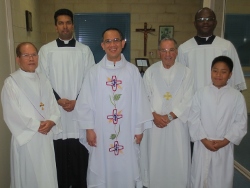
By Obet Dionisio and Bayanihan News – Philippine Christmas evening mass called Simbang Gabi which had its roots in Mexico’s Misa de Gallo were held in some Catholic churches in Blacktown area last December 16 to December 24 Christmas eve, highlighting popular Philippine Christmas tradition among Filipino residents in Sydney.
The Simbang Gabi were held in particular for Catholic adherents in the suburbs of Quakers Hill, Marayong, Glenwood, Glendenning and other suburbs.
Some young constituents who never lived in the Philippines were able to capture the ambience of the popular Filipino religious Christmas tradition held at the Mary Immaculate Church in Quakers Hill.
At the Quakers Hill church, parish priest Fr. Ruben Elago and assistant parish priest Fr. Reginald Lavilla officiated the nighly masses from December 16 to December 24.
There were other Simbang Gabi masses held in churches around Blacktown areas, specifically at St Michael church in South Blacktown, at St Aidans church in Rooty Hill and at St John the 23rd Church in Stanhope.
In his homily during one Simbang Gabi in Quakers Hill, Fr Ruben Elagu said that the roosters crow was the call for the people to wake up from their slumber noting that there was no alarm clock during those times. It was also accepted for households to leave the door and the windows open when they leave the house, with the belief that the blessings emanating from the church can go inside their houses.
He said it was a wake up call for everyone’s spiritual upliftment by sacrificing to get up early and go to mass. The opening of the doors and windows is a beacon for us to open our hearts to the blessings of our God. And the sharing of the farmer’s produce is the deed we should follow in sharing our blessings with those who are less fortunate in life and in need of help.
The Nine-Day Novena Mass prior to Christmas is part of the Roman Catholic Calendar, which is normally celebrated in the morning. In certain countries, like the Philippines and some former Spanish Colonies, the novena masses are being held at dawn, hence the title Nine-Day Dawn Masses.
In the Philippines, however, the early dawn mass had transitioned through the years into the evening mass or Simbang Gabi, also known by the other names as Misa de Gallo, or Misa de Aguinaldo.
The Dawn Masses was first introduced by Fr. Diego de Soria in Mexico in 1587, to afford the farmers to go to the mass before going to the fields to work. This is done by the farmers to seek grace for a good crop. As soon as the cocks crow, the farmers wake up, hence the term Misa de Gallo.
Since it was early morning, the farmers were bringing their breakfast, eating them after the mass before going to work, and sharing their food with those attending the mass. The farmers also bring fruits of their harvest from the previous season, so the term Misa de Aguinaldo was also used, Aguinaldo” being the Spanish word for gift-giving.
In many instances as in cultural tableu or in Filipino rural movie scenes or in Filipino artist Larry Alcala’s cartoons, the Simbang Gabi was much used to project Filipino cultural activities in celebrating Christmas. By Obet Dionisio and Bayanihan News.






Leave a Reply